Updated Sept 2024
If you want your team to be more productive, you have to learn how to collaborate.
And based on our experience working with teams both big and small, so much of effective teamwork depends on the tools in your toolbox.
The good news? There are tons of online collaboration tools to break down barriers and keep your coworkers on the same page.
That’s exactly why we put together a list of digital tools that fit the following criteria:
- They’re affordable for smaller teams (heck, some are totally free!).
- They’re web or cloud-based, meaning they can be used from anywhere.
- They have relatively low learning curves, allowing teams to adopt them ASAP.
By the end of this list, you’ll know which collaborative tools make sense for your team. Here are the areas where having a web-based collaboration software will help you and your team most:
Keep in mind that you don’t need all of the different types of tools above. As you’ll see throughout our list, many tools have multiple functions that fit the categories above. For example, RingCentral does triple duty as an all-in-one communication, task management, and file-sharing app! Finding opportunities where you can consolidate your software saves you serious time and money as your team only has to learn a single platform versus three or four tools.
Communications: You need a quick online collaboration tool—without the endless email chains
Fact: a staggering 80% of workers believe their company’s communication is either poor or average.1
Yikes. This explains the popularity of communication apps such as team messengers that keep workers from constantly playing phone tag or spending hours digging through email chains.
Not only that, but a dedicated communications platform makes the process of collaboration instant rather than something that has to be arranged ahead of time.
🔍 Are you thinking about purchasing a new communication tool and unsure how to get started? Here’s a checklist to help you pick the right one for your business.
1. RingCentral: Chat, video, and voice that integrates seamlessly with your business
Okay, we might be a little biased, but we truly think that RingCentral takes the cake when it comes to collaboration.
Our platform represents an all-in-one communications solution, combining team messaging with phone and video chat. This means that digital collaboration can be done anywhere and everywhere, which is especially great for remote workers and employees on the go.
RingCentral is a PCMag’s Editors’ Choice Award winner because of its reliable service and easy-to-use app (among other reasons)!
The ability to quickly chat and check in with colleagues and clients is a time-efficient alternative to bouncing between emails or phone calls. Rather than worry about scheduling a meeting, you can get status updates from your team in a matter of seconds.
You can likewise have a private team chat as an alternative to a traditional meeting. RingCentral makes it easy to define company-wide channels as well as “private” chats for your individual teams (think: billing, marketing, sales, and so on):
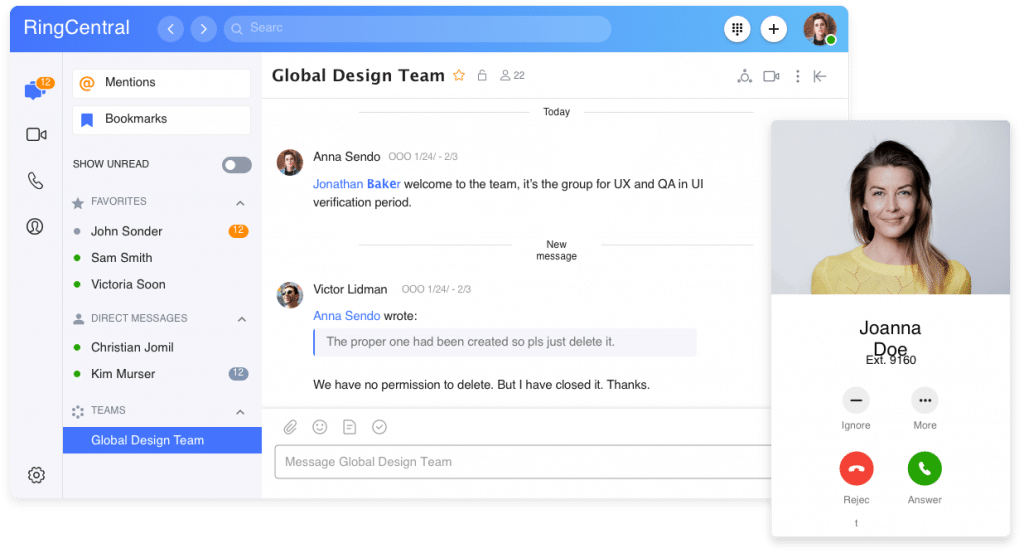
Plus, RingCentral is designed to give you crisp, HD video, which means you can enjoy virtual team collaboration that emulates a face-to-face conversation.
Collaboration-specific tools such as file sharing also empower coworkers to collaborate without having to leave the RingCentral app. An especially useful feature is the ability to annotate files and leave comments for your coworkers, meaning that your next steps and suggestions for projects are front and center:
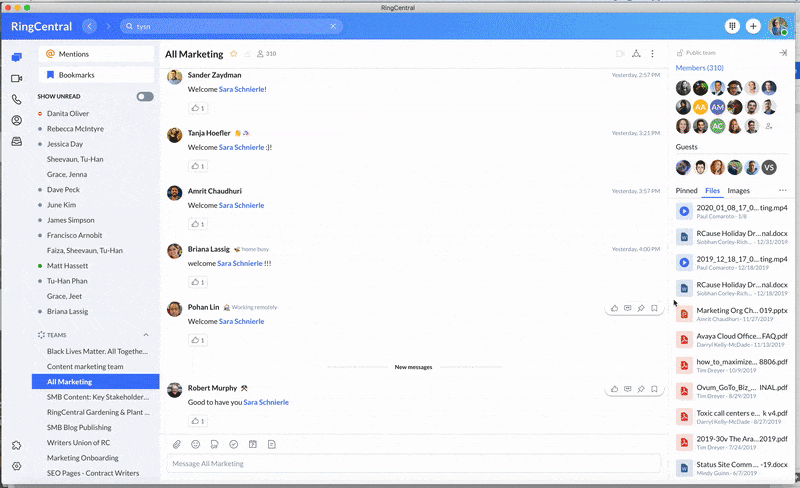
Tools like RingCentral provide everything you need to create an awesome collaboration hub for your team. Beyond the features above, RingCentral also integrates with pretty much any app your team probably already uses such as Gmail, Microsoft Teams, and Salesforce (just to name a few):
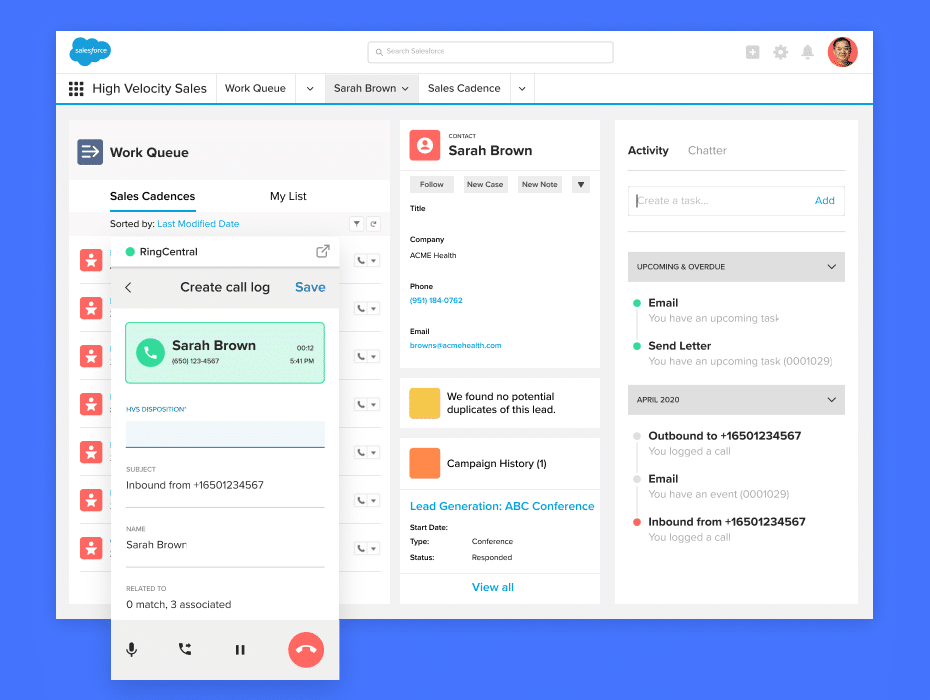
With RingCentral, you provide your team with a sort of “home base” for communication that keeps you from having to rely on a ton of different apps to get things done.
🤯 On top of all this, RingCentral could save you up to $400 an hour in IT costs.
Explore the RingCentral Advantage for small businesses:
💰 You can also use this calculator to see roughly how much your business could save by using RingCentral to support your team’s communication with each other—and clients.
2. Chanty: A basic chat solution for small businesses on a budget
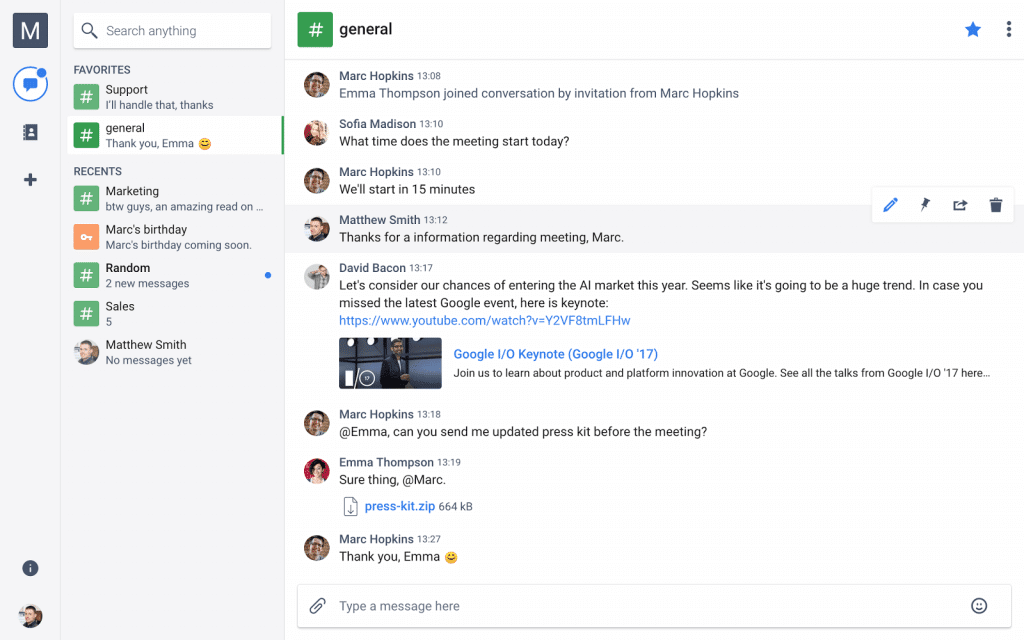
Chanty is another team messaging tool that’s noted for both its simplicity and small price tag ($3/mo per user). Beyond basic messaging, channels, and @mentions, users can assign tasks to conversations. This allows Chanty to serve as a sort of hybrid between a chat app and a calendar:
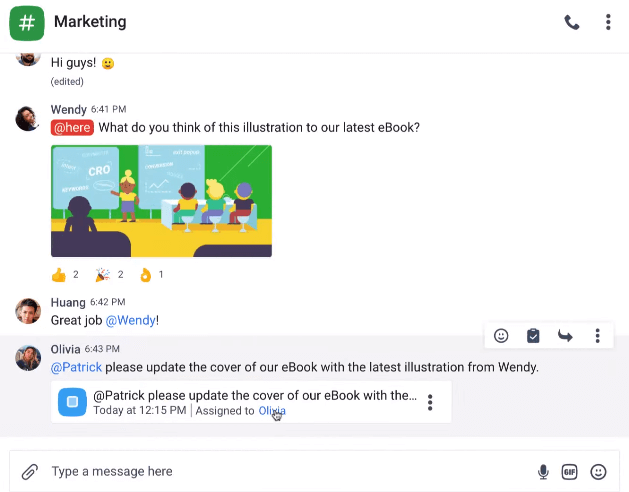
The platform’s interface may be simple and lack customization features, but that might be a bonus for teams looking for a no-frills team messaging apps.
Although Chanty does support voice and video, they aren’t exactly the app’s forte. The same rings true for whiteboard and file-sharing features as well. Even so, Chanty can get the job done for teams looking to chat and provide updates to each other beyond their inboxes.
👉 Tired of reading? Here’s a quick clip about how to build a remote work toolkit:
3. Slack: An email replacement solution for tech-savvy teams
Chances are you’ve heard of Slack given its popularity in the startup world. That said, how do its features and functionalities translate to small businesses?
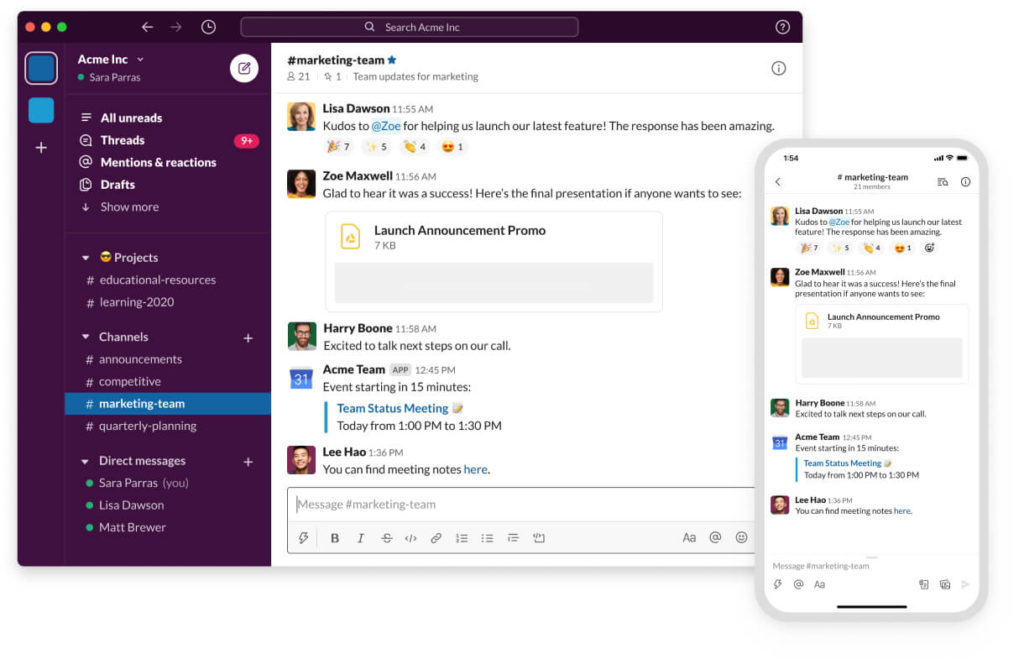
Slack is notable for not only its dedicated channels and @mention notifications, but also its lighthearted emojis and integrations with other apps. This includes productivity bots, storage apps like Google Drive, and video tools like Zoom.
That said, the platform’s out-of-the-box features might leave a bit to be desired for small businesses. Plus, if you’re looking for a more comprehensive or versatile communication platform that includes a phone service and robust video conferencing, Slack may not be the best option.
Slack markets itself as a sort of “email replacement,” meaning that making the platform work means getting your employees to really buy in to using it as an alternative to their email inboxes. However, this can be a challenge for teams that are newer to chat apps. You likewise don’t want to be in a situation where your employees are drowning in Slack notifications via email, defeating the whole purpose of the app.
Project management: Encouraging accountability and transparency across every team project
Project management apps are among the most popular types of collaboration tools for businesses.
Perhaps that’s because companies with a defined project management process are much more likely to complete tasks on time and under budget.2
From day-to-day duties to long-term projects, the apps below provide a centralized place to collaborate. These tools also create a sense of transparency and accountability for team members to contribute and pull their weight on any given project.
4. Trello: A forever-free solution for businesses new to project management
Trello’s forever-free platform (for up to 10 teams) and basic, color-coded, drag-and-drop interface makes it an ideal solution for small businesses new to project management. Even if you’ve never worked with a Kanban board before, Trello is both intuitive and quick to learn for total newbies:

The concept behind your Trello board is simple: consolidate updates and status reports of any given project without having to do so exclusively through email. Checking in on your Trello boards, you can quickly see if a task is in progress or an issue needs to be addressed, meaning you never have to second-guess “what’s next” on your schedule.
Email notifications and integrations with your team messaging apps (like RingCentral!) also make sure that your team never accidentally misses out on an update. This is yet another example of how your online collaboration tools can work together.
Trello is ideal for smaller teams and projects with fewer progress steps. Likewise, making any sort of project management tool actually effective means ensuring that everyone on your team is on board. For example, if someone consistently fails to tag teammates or update their progress, the function of the board sort of falls apart.
But for teams that buy into project management, Trello is arguably one of the best free online collaboration tools out there.
5. ClickUp: An in-depth project management calendar with an emphasis on team productivity
ClickUp claims that it can help teams save up to one day per week in lost productivity. Sounds nice, right?
Not unlike Trello, ClickUp provides a basic project status overview and makes it easy for collaborators to move boards from Point A to Point B. The platform’s interface makes it clear who’s working on a task at any given time:
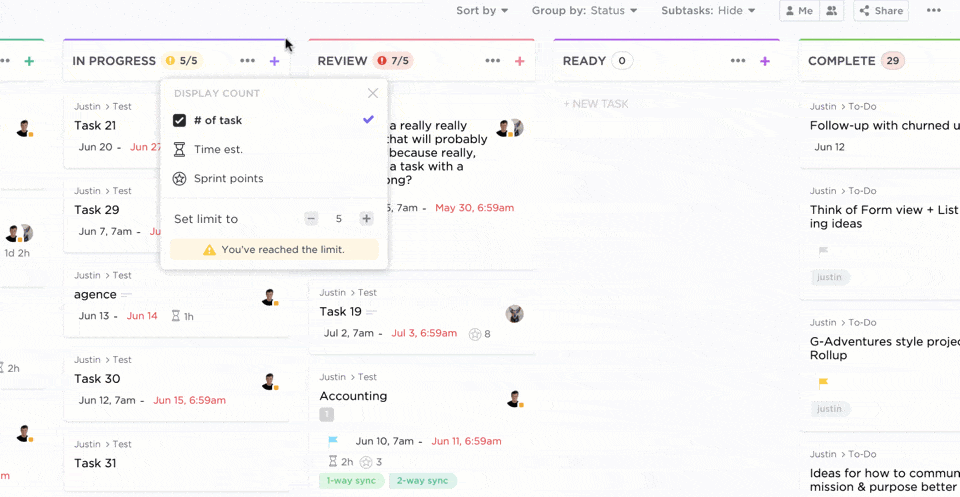
What’s notable about ClickUp is its customization features that are compatible with both visual preferences and just about any project management style. In addition to a more traditional “board” view, you can also look at your team’s progress as a list, calendar, document, or “box view”:
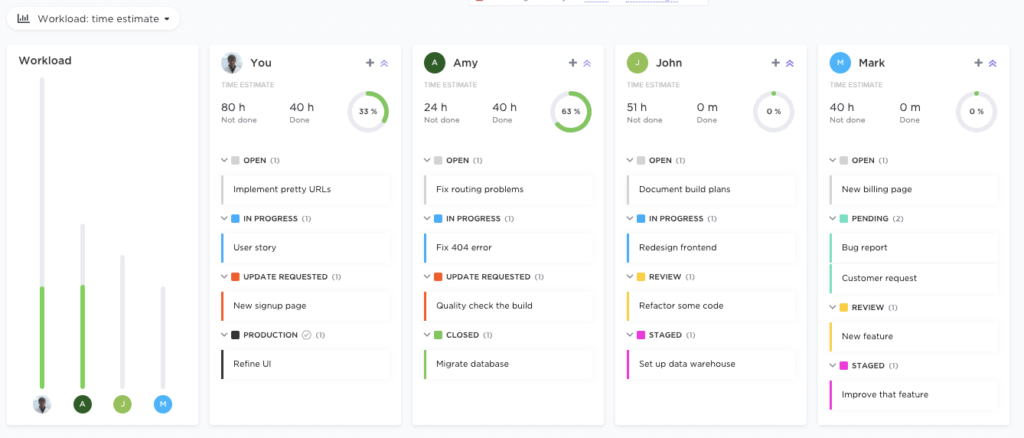
This digs into another key feature of ClickUp: analytics. By tracking individual productivity, you can keep a pulse on each team members’ schedule and productivity. Of course, this might feel a bit Big Brother-ish as an employee, so avoiding micromanaging your team is key to making a system like ClickUp work.
ClickUp is surprisingly robust for its price tag, but like any project management app, however, making use of all of these features does require consistent participation from your team.
6. Monday.com: A flexible project management solution with visual versatility
Monday.com is another popular platform that provides a bird’s-eye view of your team’s statuses on projects. Much like ClickUp, you can seamlessly switch from board to calendar or team view (among others). This combined with Monday.com’s color-coded status updates makes it a great tool for anyone who considers themselves a visual learner:
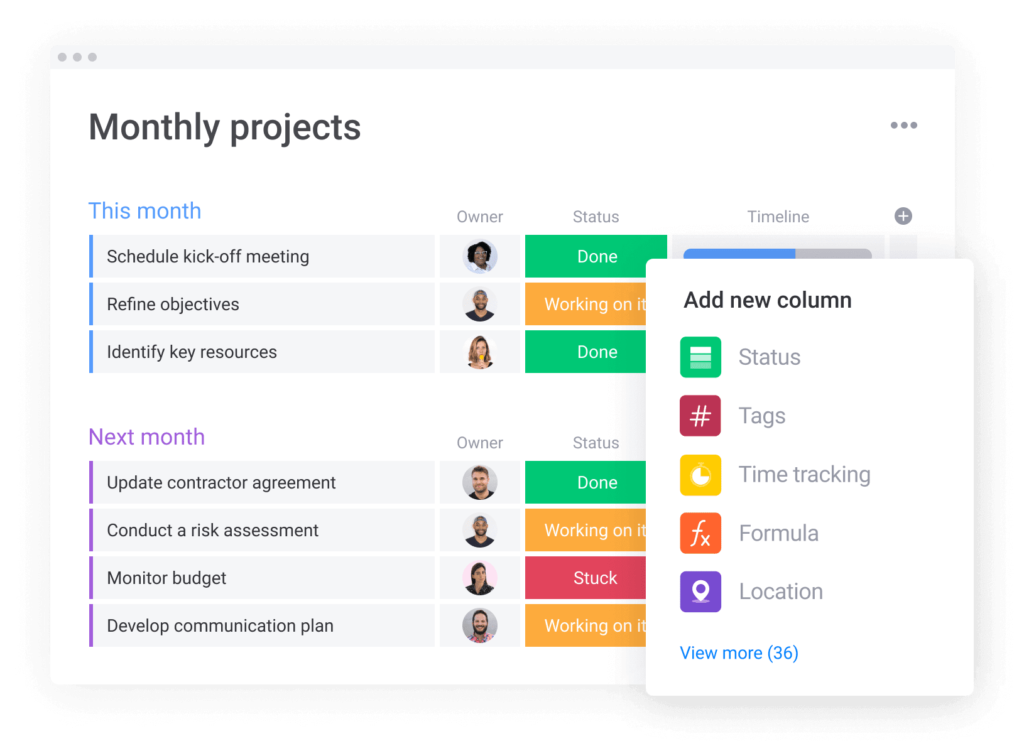
Another bonus of Monday.com is the ability to create in-app automations such as follow-ups and notifications to keep projects moving. You can likewise control stakeholders to ensure that collaborators have the proper permissions. Much like many of the other online collaborations on our list, Monday.com also has integrations aplenty.
Although Monday.com is definitely accessible for smaller teams, making the most of it is going to require an initial investment of your team’s time.
Task management: Manage your day-to-day schedule alongside your team’s tasks
To say that the average worker has a ton on their plate would be the ultimate understatement. The tools below serve as a supplement or alternative to project management tools, providing teams with a clear way to block out their time and prioritize tasks with features like automations.
7. Todoist: An intuitive task management tool for professionals and small teams
Think of Todoist as a sort of professional to-do list that your colleagues and coworkers can interact with. This allows you to tackle your own day-to-day tasks with a sense of clarity while also making sure that your schedule isn’t totally siloed off from your team:
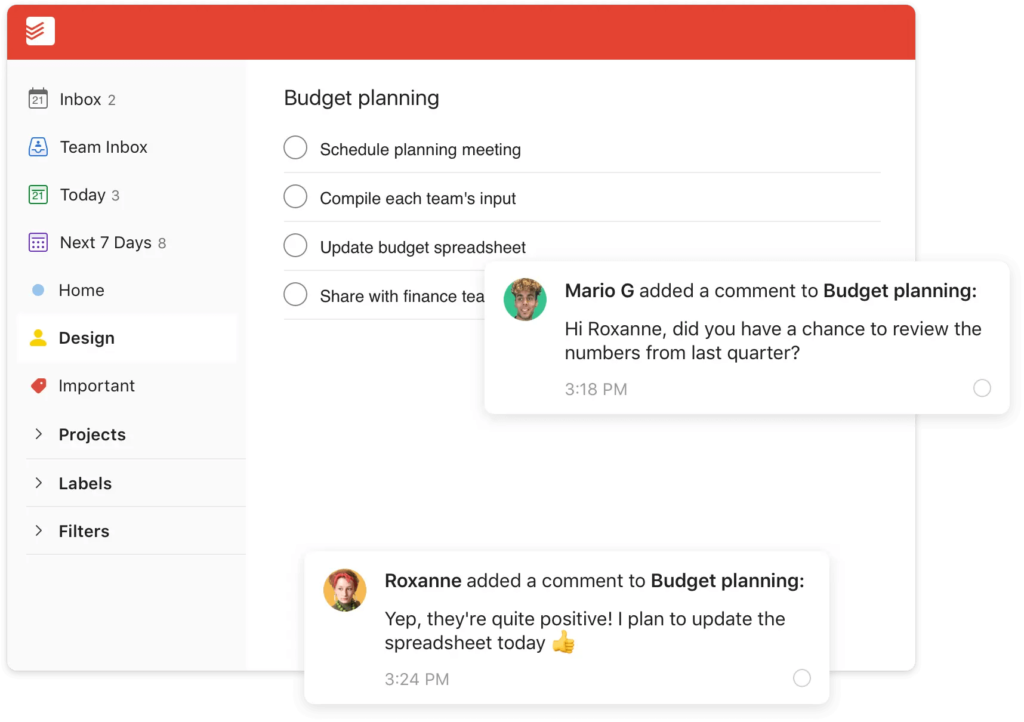
With Todoist, you can create daily or weekly schedules, in addition to recurring tasks and due dates for meetings or deadlines that happen on a consistent basis. The platform allows you to delegate, comment on, and share tasks with others to encourage teamwork. The fact that Todoist works across devices means that updates and edits can be made from anywhere.
If you have a smaller team, Todoist is a simpler but still very effective alternative to a traditional Kanban board.
8. HoneyBeeBase: No-frills schedule management for businesses that want to keep it simple
Among our examples of collaboration tools, HoneyBeeBase is definitely the most “old-school.” That said, the no-frills interface might appeal to teams who aren’t exactly tech-savvy. The platform’s features include schedule mapping and time tracking, serving as an alternative to spreadsheets and reports to inform managers on how projects are moving along:
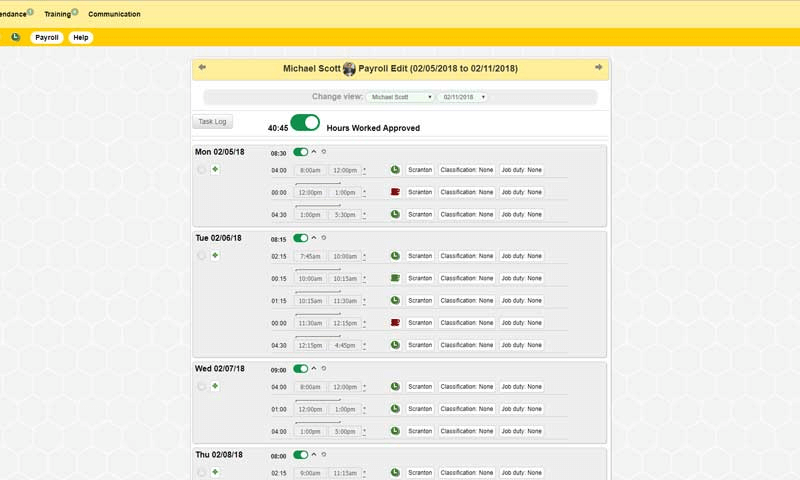
While the platform might not be the most mind-blowing aesthetically or feature-wise, HoneyBeeBase gets the job done for assigning tasks, due dates, and managing schedules in a single place.
9. Wrike: Team-wide task management meets file sharing
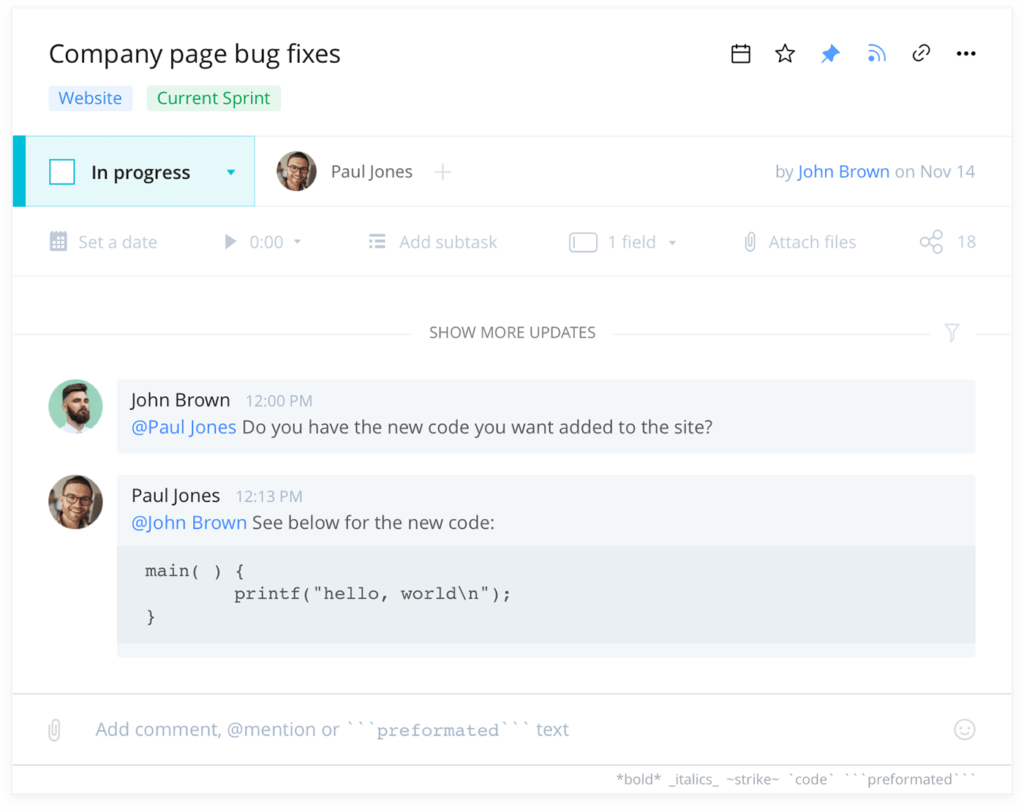
Like Todoist, Wrike allows users to manage their own to-do lists while allowing collaborators to drop-in and comment as well. The mission of Wrike in their own words is to “break down silos” and create a sense of transparency among teams.
The platform is straightforward visually and is also notable for its uptime and security settings. Ownership customization, project calendars, and status updates are also built into Wrike. The tool’s Chrome extension is a nifty feature, letting users check the status updates of their to-do lists without having to open the app itself.
Document and file-sharing: Collaborate on files without clutter or chaos
Wrangling files and documents can be an absolute nightmare if you’re doing so exclusively through email. Likewise, you open your company up to a whole slew of security issues when your business’s files aren’t under lock and key.
Below are some file-sharing apps that double as collaborative workspaces, letting you and your team work on documents without stepping on anyone’s toes.
10. Google Docs: Swift and simple document collaboration
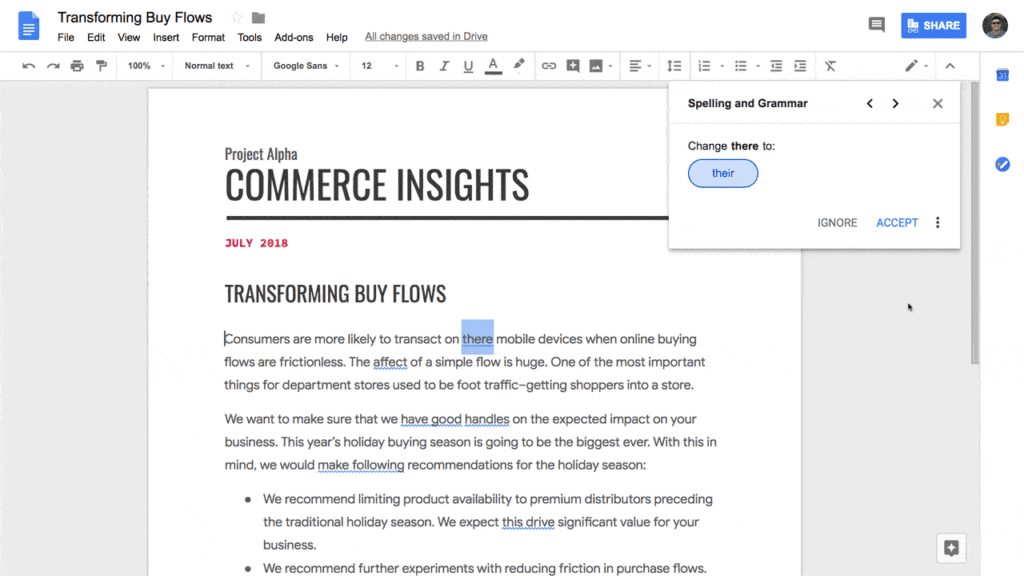
Perhaps one of the most widely-used office collaboration tools out there, Google Docs is tried and trusted by millions of people for a reason. The platform is perfect for working alongside collaborators on everything from contracts to blog posts and beyond. Google Docs not only tracks edits but allows users to make comments to clarify changes.
The ability to quickly pull up a document’s version history and restore to previous files makes sure that progress on a document never gets “lost.” Also, document creators have control over who has access to a file to prevent security issues. If you’re already using Gmail or Google Workspace, getting on board with Docs is a no-brainer.
11. Dropbox: A file-sharing workspace for teams serious about collaboration
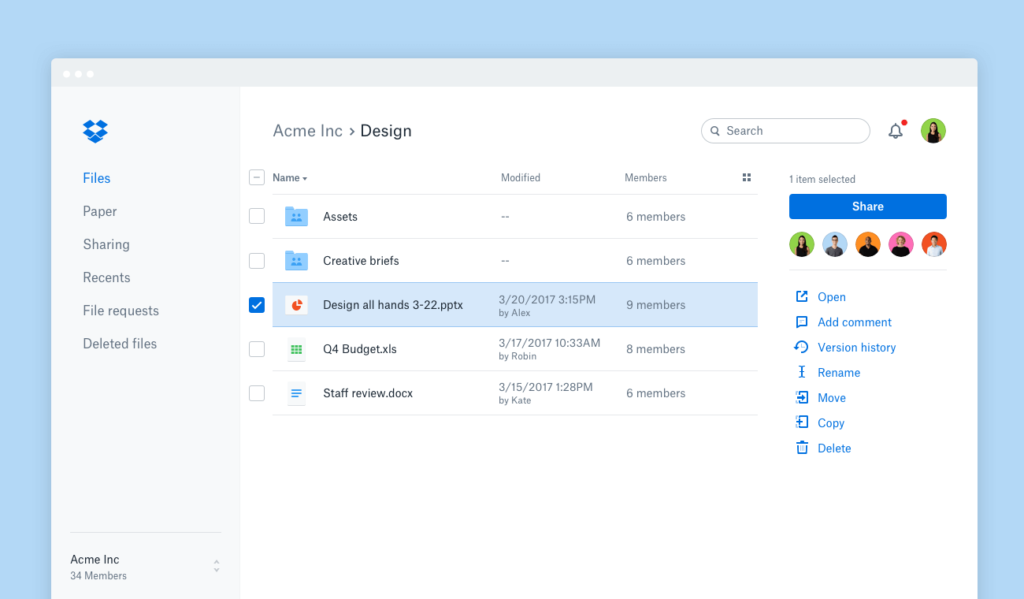
Dropbox is a full-blown collaborative online workspace, taking the file-sharing and collaborative features of Google Docs and putting them on steroids.
Beyond edits and annotations, the platform prioritizes productivity by suggesting file destinations, collaborators, and shortcuts to keep projects moving. Dropbox is among the pricier digital collaboration tools on our list, but is worth it for teams working with massive files.
12. Box: A shared file-sharing workspace with security and user controls in mind
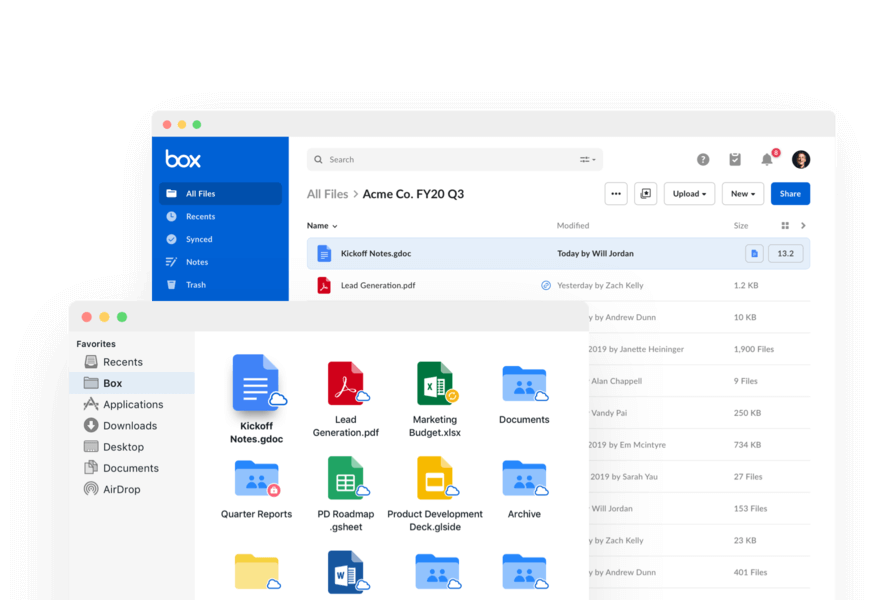
Another shared workspace, Box is a robust file-sharing and storage platform that also features collaborative document sharing, file syncing, and note taking. Administrative control and emphasis on security is Box’s selling point, as is the ability to edit 120+ file types. The ability to set unique permissions is particularly useful for larger teams and restricting access to sensitive documents.
Design and branding: Manage your company’s creative materials in one place
Putting together design mock-ups or other branded materials is a pretty involved process, sure, but it still shouldn’t mean endless back-and-forths or in-person meetings. To wrap things up, we’ll take a look at a couple of online collaborative tools that cover the creative side of your business.
13. LucidPress: Emphasize consistency during creative collaboration

LucidPress allows you to create custom brand templates for everything from ads to marketing materials and beyond. The platform’s editor itself is akin to something like Photoshop, allowing creators to start from scratch or edit pre-built templates to match their own brand creatives.
In addition to creating and editing, you can collaborate online with your team on LucidPress through co-owned company templates. Features such as real-time commenting and chat mean that feedback can be provided among teams instantly.
Another notable feature is the ability to save branded color schemes and past assets. Managers can likewise control who has access to particular materials through permissions or “lock” templates to avoid accidentally losing anything:
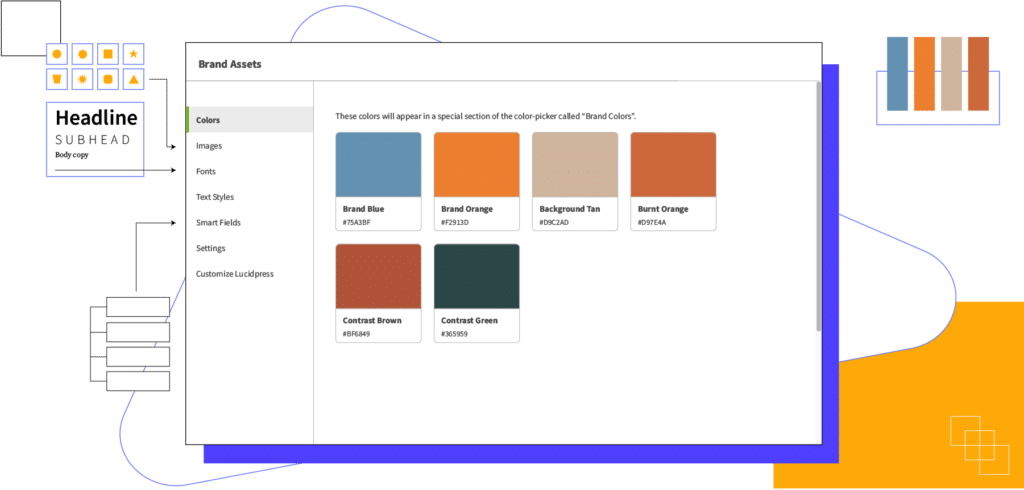
14. Bannersnack: Putting feedback front and center during the creative process
Bannersnack’s namesake comes from its emphasis on creating banners that are prime for blog posts, social media, and email. Like LucidPress, you can work off of templates or create your own marketing materials from scratch:
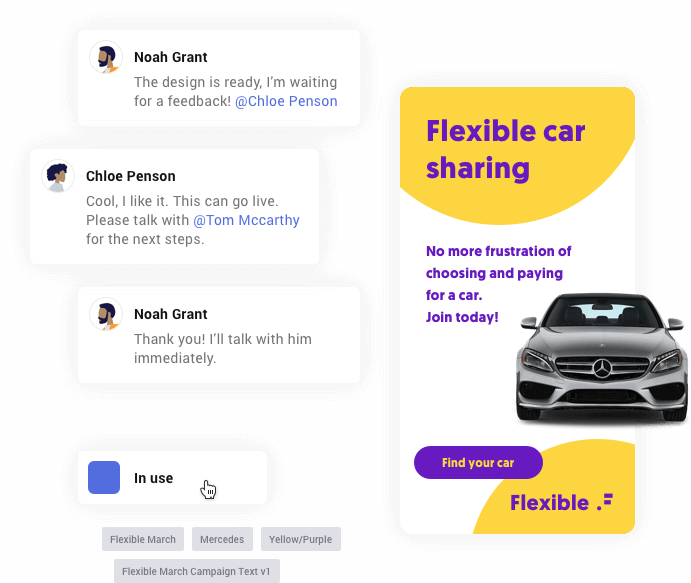
15. Canva Draw
Canva Draw revolutionizes the way teams collaborate creatively. This dynamic drawing app, available on the Canva platform, is designed to seamlessly integrate into your team’s workflow, enabling real-time idea generation and artistic brainstorming.

With Canva Draw, you have an infinite canvas to express creativity. Its multiple pen options, including Pen, Marker, and Highlighter, cater to various drawing needs. The intuitive Shape Assist feature transforms rough sketches into polished diagrams and maps, making it ideal for fast-paced brainstorming sessions.
Which online collaboration tools make sense for your team?
Listen: “teamwork” obviously isn’t a one-size-fits-all term for today’s businesses.
There are obviously different types of collaboration tools out there, but the apps above represent a cost-effective way for teams of all sizes to get their work done faster.
And regardless of what tools you’re using, make sure that you have a good communication platform to handle your team’s internal (and customer-facing!) calls, emails and messages.
1project.co/communication-statistics-2020
2pmi.org/-/media/pmi/documents/public/pdf/learning/thought-leadership/pulse/pulse-of-the-profession-2018.pdf
Originally published Jul 01, 2020, updated Feb 08, 2024





